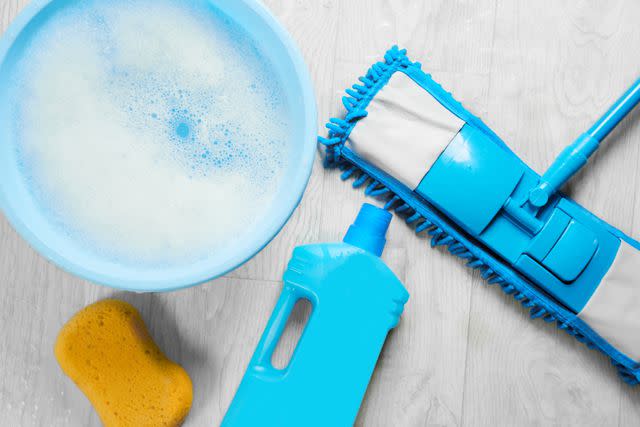5 Things You Can Put in Mop Water for Fresh-Smelling, Sparkling Floors
The best part? You can find these items in your pantry or medicine cabinet.
Trying to figure out what to put in mop water to get sparkly clean floors? Turns out, there are all sorts of cleaning agents you can leverage for the job, each with their own perks. While some mop water concoctions can work across the board, it’s technically better to choose a mixture that works best for your specific flooring type.
For example, you wouldn’t necessarily use the same mixture for wood flooring as you would for tile, and laminate floors also have their own needs. We asked cleaning experts about how they prepare mop water according to different floor types to ensure the cleanest floors.
Related: This Is How Often Should You Mop Your Floors

Amix Studio/Getty Images
Dish Soap
When in doubt about what to put in mop water, reach for your handy bottle of dish soap and dunk your mop into a sudsy mixture. “This mop water solution is safe, effective, and convenient—who doesn’t have dish soap at home?” says cleaning professional Robin Murphy, founder of ChirpChirp. “It penetrates dirt and grime on floors while being mild and won’t cause damage as long as you don’t use too much water.”
Best For: Ceramic tile, stone, sealed wood, laminate, vinyl, and linoleum
Ratio: 5 to 10 drops of dish soap per gallon
Rinsing Required?: Yes, go back with a second pass of plain hot water to make sure any soap residue is removed.
Rubbing Alcohol
Rubbing alcohol is a convenient, efficient, and cost-effective cleaning agent you can put in mop water. It’s also a powerful germicide, which means it can squash bacteria, viruses, mold, and fungus. “Rubbing alcohol is great for helping cut through dirt while sanitizing the surface,” says Kathy Cohoon, cleaning professional at Two Maids. “It can also help get rid of odors.”
Best For: Laminate, hardwood, sealed tile, luxury vinyl
Ratio: 1 cup per gallon
Rinsing Required?: No, you do not need to rinse. In fact, allowing it to set can make it more effective at killing germs and bacteria.
Vinegar
Vinegar is a bacteria-busting hero that belongs in every home. It’s best for very hard floors, such as tile and laminate, and shouldn’t be used on "softer" flooring such as hardwood, marble, and travertine. Murphy says, “For hard surface floors, the acidity of vinegar, which has a pH level two to three, removes dirt without harming the finish.”
Best For: Tile, vinyl, linoleum, laminate
Ratio: ½ cup per gallon
Rinsing Required?: No, you don’t need to rinse it.
Borax
If you’ve got a tough job, Borax is a powerful cleansing agent similar to baking soda (though more alkaline) that targets deep stains and grime. It santizes and "is good at removing stains because it’s slightly abrasive and deodorizes odors,” notes Murphy. “It’s also cost-effective, inhibits the growth of mold and mildew, and is effective against household insects like ants and cockroaches.”
Best For: Tile, concrete, sealed stone, concrete, vinyl, and linoleum.
Ratio: ⅛ cup per gallon
Rinsing Required?: Yes, borax can leave residue behind. Complete a second pass with plain water.
Commercial Floor Cleaner
Of course, using premade floor cleaner is always an option. For example, Lysol, Fabuloso, and Clorox are examples of brands that make special mop cleaning solutions (and multi-purpose cleaners). Each product formulation has its own usage instructions, so double check the label to make sure it’s suitable for your flooring type and refer to the dilution advice to ensure you’ve got the perfect ratio.
Best For: Depends on product
Ratio: Follow label usage instructions
Rinsing Required?: Refer to instructions
Tips
No matter the mopping mixture you prefer, Cohoon says to remember to change out the water frequently since mopping with dirty water will only get you, well, dirty floors! And if you’re uncertain about using a specific ingredient, double check the flooring manufacturer instructions.
Safety Info on Mixing Cleaning Ingredients
You can always get fancy and whip up your own concoction of cleaning agents and water. However, certain cleaning chemicals don’t play nicely with each other, and some can even create a toxic environment.
For example, bleach and vinegar can create chlorine gas, bleach and ammonia (found in numerous cleaners, such as Windex) can create a toxic substance called Chloramine, and bleach and rubbing alcohol creates a highly toxic solution called chloroform. Simplicity in cleaning often works best, but if you do mix ingredients double check beforehand that it’s OK to do so.
Related: The 12 Best Mops of 2023, Tested and Reviewed
For more Real Simple news, make sure to sign up for our newsletter!
Read the original article on Real Simple.
